We Don’t Know yet, but You Can Minimize the Risk of Breakouts by Following These Tips

The Essential Info
No research studies have looked at whether exercising with makeup on might trigger or intensify acne, so we can’t say what effect it might have.
To be on the safe side and minimize any potential risk, follow these guidelines for combining exercise with makeup:
- If you are faced with a choice between working out with makeup on and not working out at all, choose working out with makeup on to reap the many proven benefits of exercise, which may include a possible reduction in acne.
- It is best to wash your skin only twice per day. Plan to shower and complete your anti-acne skincare regimen after your workout to minimize the number of times you wash your skin in a single day.
- Go makeup free when you can.
- Choose makeup that is free of comedogenic (pore-clogging) ingredients and fragrances.
- Physical irritation of the skin can aggravate acne, so always remove makeup very gently. Blot away sweat very gently as well.

The Science
Many people today wear makeup while exercising. Maybe you head to the gym straight after work or school and don’t have time to remove your makeup, or perhaps you simply feel more comfortable and confident with your makeup on. But could exercising with makeup on be causing breakouts or making your acne worse?
No studies to date have looked at how wearing makeup during exercise might affect acne or skin health in general. However, we do know that some cosmetics can trigger acne.1,2 There is also a lot of evidence that rubbing the skin or handling it roughly can create physical irritation, which in turn can worsen acne.3 Keeping this in mind, and based on everything we know about the science of acne, we have developed some guidelines to help you decide whether to wear makeup to the gym:
Guidelines for Makeup During Exercise
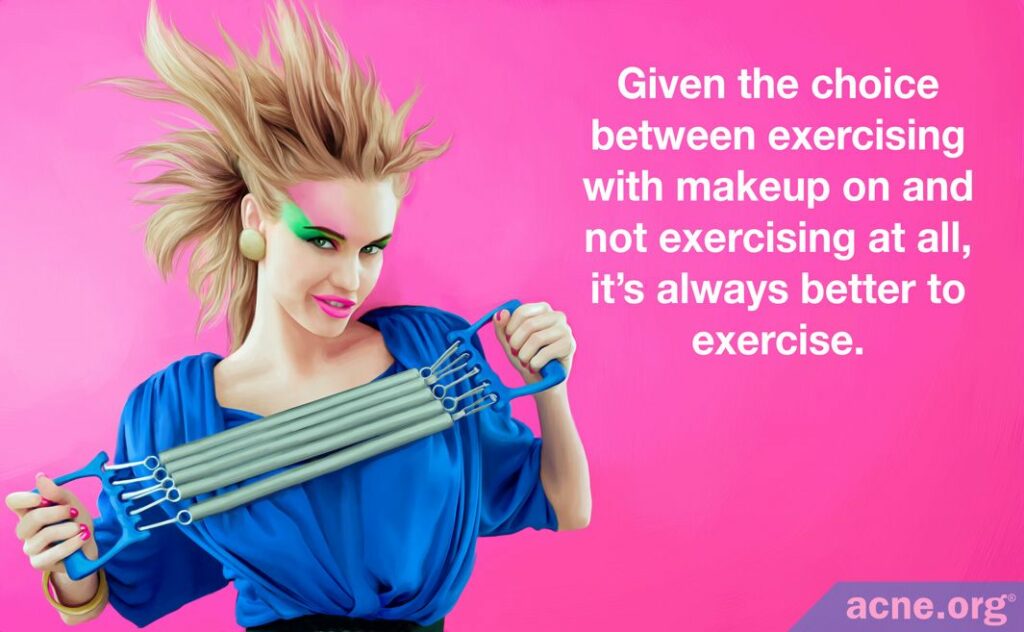
1. Given a choice between going to the gym with makeup on and not going at all, choose to go: Regular exercise has many proven health benefits and may actually improve acne by decreasing inflammation in the body.4-6 Even sweat produced during exercise may help fight acne by killing bacteria in skin pores.7 Therefore, given the choice between exercising with makeup on and not exercising at all, it’s always better to exercise.
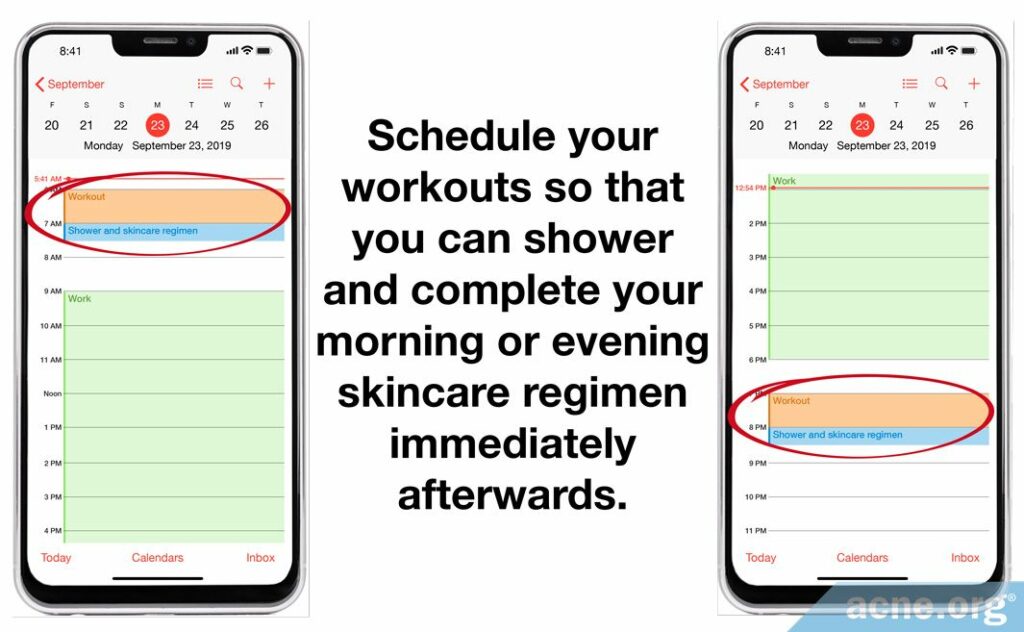
2. Plan to shower and complete your acne skincare routine after your workout: Washing your face more than twice a day can cause unnecessary skin irritation and contribute to the cycle of acne. Therefore, it is best to schedule your workouts first thing in the morning or later in the evening, so that you can shower and complete your morning or evening skincare regimen immediately afterwards. Even if you need to work out in the middle of the day, plan to shower and do your “evening” skincare regimen afterwards, and skip doing the regimen before bed. This will minimize the chances of irritating your skin by excessive washing.
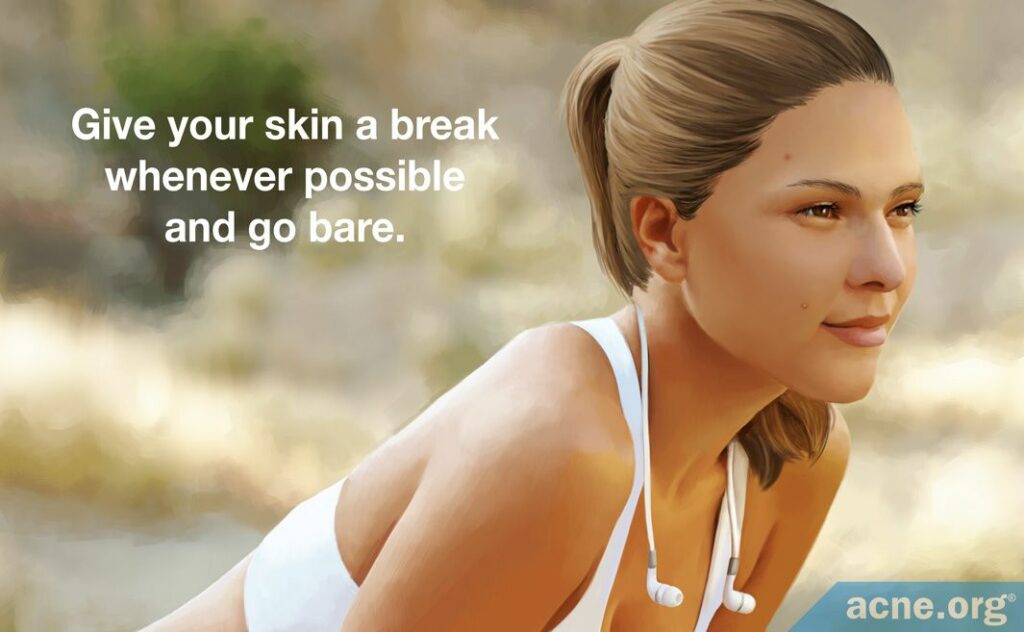
3. Go makeup-free when you can: While makeup itself, when chosen correctly, is not necessarily problematic for acne-prone skin, the act of putting on and removing makeup can potentially irritate the skin and contribute to acne.3 Therefore, it is a good idea to give your skin a break whenever possible and go bare.
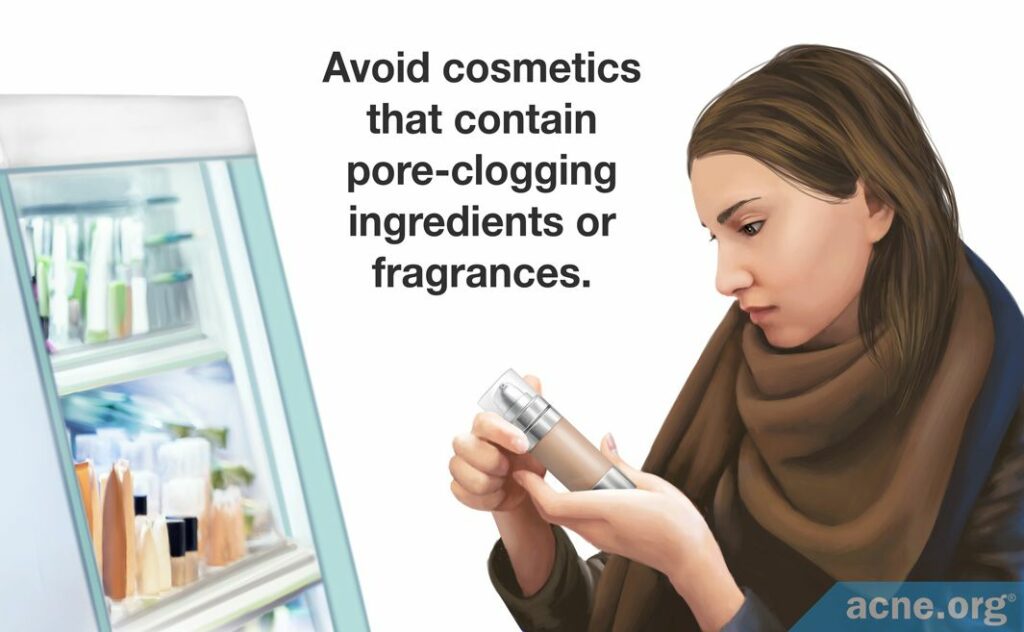
4. Choose your makeup carefully–avoid pore-clogging ingredients and fragrances: Before buying any makeup product, always check the ingredient list. Avoid cosmetics that contain comedogenic (pore-clogging) ingredients as they can cause so-called acne cosmetica, which basically means cosmetics-related breakouts.8 In addition, avoid fragranced products, because certain fragrances may cause skin irritation and/or allergies in some people.
Expand the drawer below for a table that gives a complete list of common comedogenic ingredients.
List of Common Comedogenic Ingredients
Based on a thorough review of the available research on pore-clogging substances,1 we have compiled two lists:
- Definitely avoid: These are ingredients that people with acne-prone skin should definitely avoid, because a substantial amount of evidence shows that they are comedogenic.
- Consider avoiding: These are ingredients that people with acne-prone skin may want to consider avoiding, because some evidence suggests that they might be comedogenic.
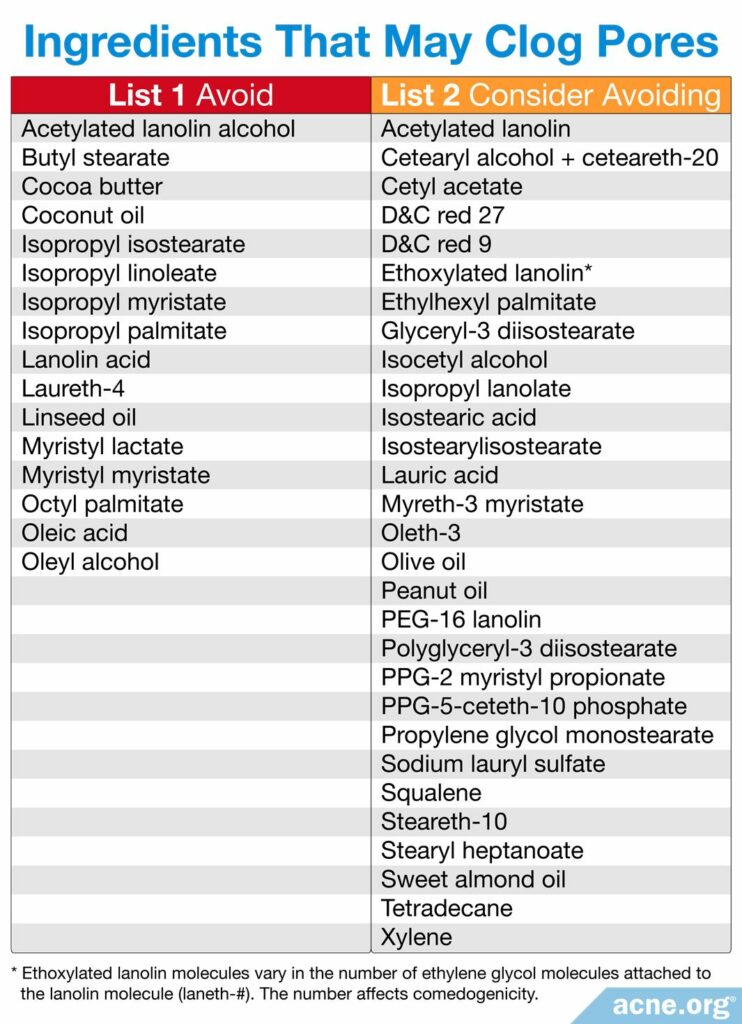
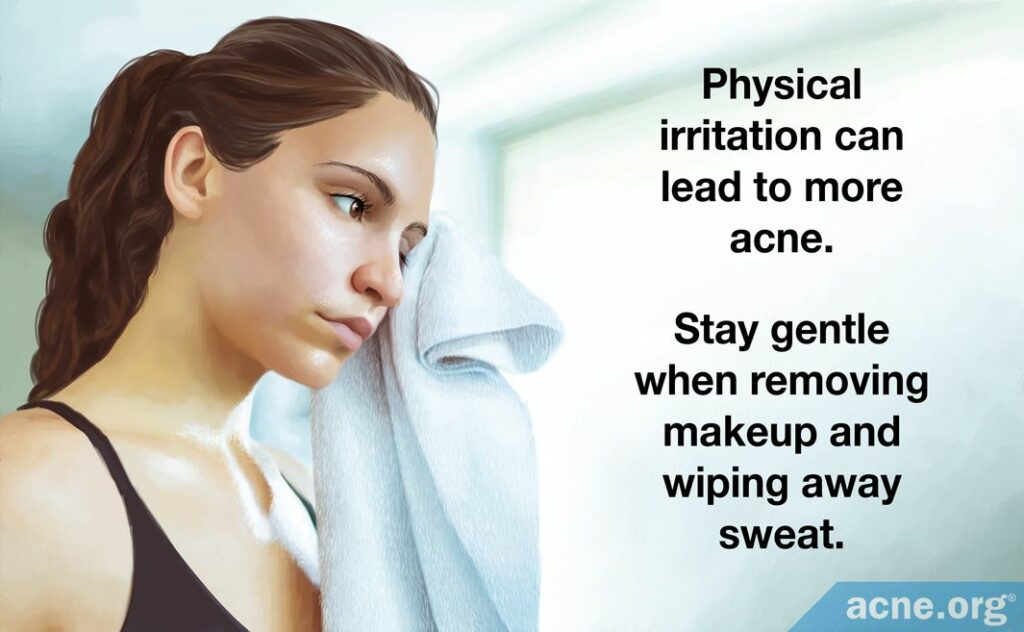
5. Be gentle to your skin when removing makeup and wiping away sweat: Whenever you remove makeup, whether before or after a workout, use a gentle touch to avoid irritating the skin. The same applies to wiping away sweat. While sweat itself does not appear to be harmful to acne-prone skin,9 wiping away sweat with a rough towel can definitely cause irritation and intensify acne. Instead of wiping, gently blot sweat away using a soft towel. When it comes to choosing makeup removers and/or cleansers, look for gentle products with labels like “mild,” “non-irritating,” or even “for acne-prone skin.”
References
- Katoulis, A. C., Kakepis, E. M., Kintziou, H., Kakepis, M. E. & Stavrianeas N. G. Comedogenicity of cosmetics: a review. Journal of the European Academy of Dermatology and Venereology 7, 115-119 (1996). https://onlinelibrary.wiley.com/doi/abs/10.1111/j.1468-3083.1996.tb00606.x
- Conforti, C., Giuffrida, R., Fadda, S., Fai, A., Romita, P., Zalaudek, I. & Dianzani, C. Topical dermocosmetics and acne vulgaris. Dermatol. Ther. 34, e14436 (2021). https://pubmed.ncbi.nlm.nih.gov/33084158/
- Mills, O. & Kligman, A. Acne mechanica. Archives of Dermatology 111, 481-483 (1975). https://www.ncbi.nlm.nih.gov/pubmed/123732
- Beavers, K. M., Brinkley, T. E. & Nicklas, B. J. Effect of exercise training on chronic inflammation. Clin. Chim. Acta 411, 785 – 793 (2010). https://www.ncbi.nlm.nih.gov/pubmed/20188719
- Nimmo, M. A., Leggate, M., Viana, J. L. & King, J. A. The effect of physical activity on body fat. Diabetes, Obes. Andm. 15, 51 – 60 (2013). https://onlinelibrary.wiley.com/doi/full/10.1111/dom.12156
- Wärnberg, J., Cunningham, K., Romeo, J. & Marcos, A. Physical activity, exercise and low-grade systemic inflammation. Proc. Nutr. Soc. 69, 400 – 406 (2010). https://www.ncbi.nlm.nih.gov/pubmed/20598198
- Nakano, T., Yoshino, T., Fujimura, T., Arai, S., Mukuno, A., Sato, N. & Katsuoka, K. Reduced expression of dermcidin, a peptide active against Propionibacterium acnes, in sweat of patients with acne vulgaris. Acta Dermato-Venereologica 95(7), 783-786 (2015). https://www.ncbi.nlm.nih.gov/pubmed/25673161
- Baek, J. H., Ahn, H. J., Koh, J. S., Kwon, H. & Shin, M. K. Early detection of microcomedones induced by cocoa butter using reflectance confocal microscopy. J. Cosmet. Dermatol. 21, 3016-3021 (2022). https://pubmed.ncbi.nlm.nih.gov/34632684/
- Short, R., Agredano, Y.Z., Choi, J. & Kimball, A.B. A single-blinded, randomized pilot study to evaluate the effect of exercise-induced sweat on truncal acne. American Journal of Clinical Dermatology 25(1), 126-128 (2008). https://www.ncbi.nlm.nih.gov/pubmed/18304176
 Acne.org Products
Acne.org Products